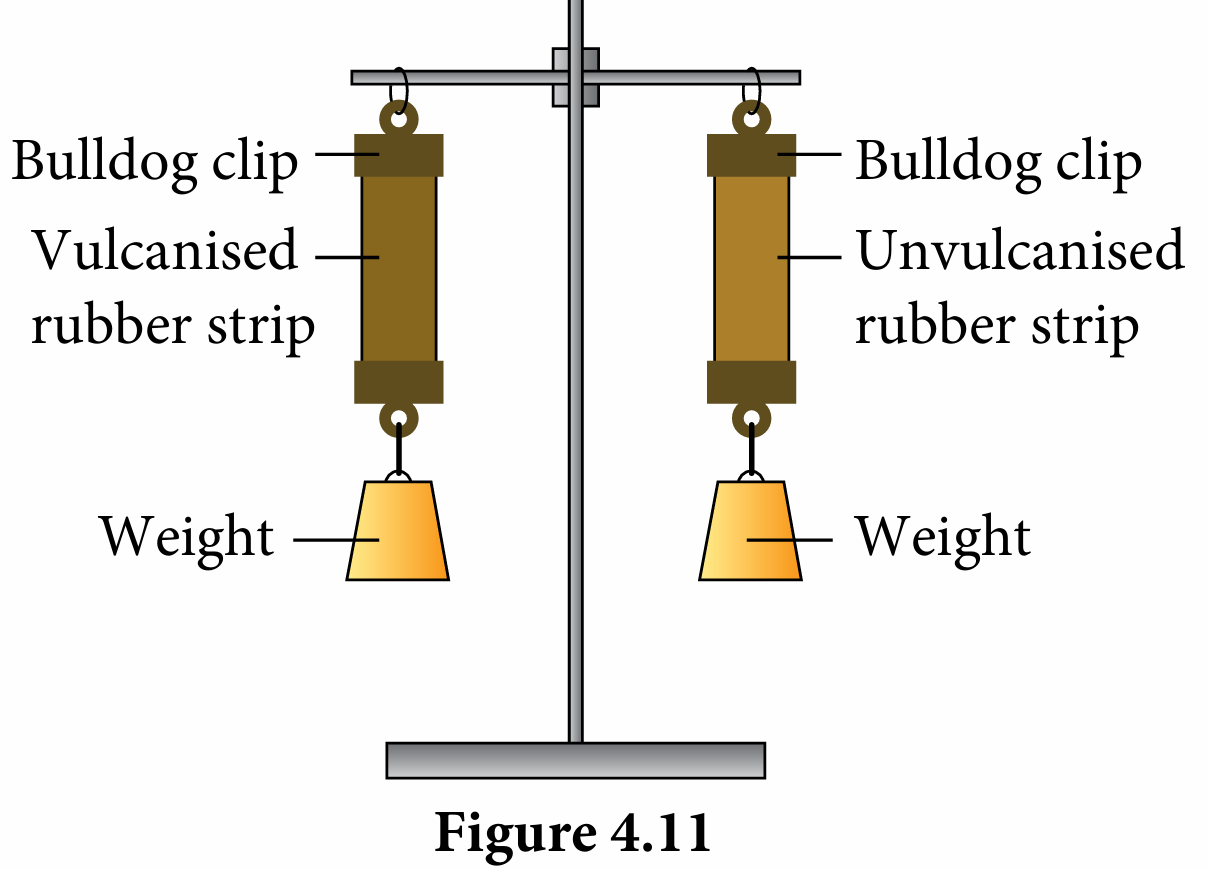Experiment 4B (Investigating the Elasticity of Vulcanised Rubber):
Aim: To investigate the elasticity of vulcanised and unvulcanised rubber.
Problem statement: Is vulcanised rubber more elastic than unvulcanised rubber?
Hypothesis: Vulcanised rubber is more elastic than unvulcanised rubber.
Variables:
(a) Manipulated variable : Vulcanised and unvulcanised rubber strips.
(b) Responding variable : The elongation of rubber strips when the weight is removed.
(c) Fixed variable : Size of rubber strip and the mass of weight used.
Materials: Vulcanised and unvulcanised rubber strips.
Apparatus: Retort stand, bulldog clip, 50 g weight and metre ruler.
Procedure:
1. Hang the two rubber strips on the retort stand using bulldog clips as shown in Figure 4.11.

2. Measure and record the initial length, L1 of both rubber strips to be used in this experiment.
3. Hang a 50 g weight on each rubber strip and record each final length, L2.
4. Remove the weights, and once again, record the length, L3 of each rubber strip.
Results:
Create a suitable table to record all readings.
Discussion:
1. Which rubber strip shows the highest elongation?
2. Which strip is more elastic? Explain your answer based on the results obtained.
3. Predict which rubber strip will snap first if the mass of the weight continues to increase.
4. What can be concluded from this experiment?
Answer:
1. Unvulcanised rubber strip,
2. Vulcanised rubber strip. Able to return to its original length after the weight is removed.
3. Unvulcanised rubber.
4. Conclusion: Hypothesis is accepted. Vulcanised rubber is more elastic than unvulcanised rubber.
Aim: To investigate the elasticity of vulcanised and unvulcanised rubber.
Problem statement: Is vulcanised rubber more elastic than unvulcanised rubber?
Hypothesis: Vulcanised rubber is more elastic than unvulcanised rubber.
Variables:
(a) Manipulated variable : Vulcanised and unvulcanised rubber strips.
(b) Responding variable : The elongation of rubber strips when the weight is removed.
(c) Fixed variable : Size of rubber strip and the mass of weight used.
Materials: Vulcanised and unvulcanised rubber strips.
Apparatus: Retort stand, bulldog clip, 50 g weight and metre ruler.
Procedure:
1. Hang the two rubber strips on the retort stand using bulldog clips as shown in Figure 4.11.

2. Measure and record the initial length, L1 of both rubber strips to be used in this experiment.
3. Hang a 50 g weight on each rubber strip and record each final length, L2.
4. Remove the weights, and once again, record the length, L3 of each rubber strip.
Results:
Create a suitable table to record all readings.
Discussion:
1. Which rubber strip shows the highest elongation?
2. Which strip is more elastic? Explain your answer based on the results obtained.
3. Predict which rubber strip will snap first if the mass of the weight continues to increase.
4. What can be concluded from this experiment?
Answer:
1. Unvulcanised rubber strip,
2. Vulcanised rubber strip. Able to return to its original length after the weight is removed.
3. Unvulcanised rubber.
4. Conclusion: Hypothesis is accepted. Vulcanised rubber is more elastic than unvulcanised rubber.
